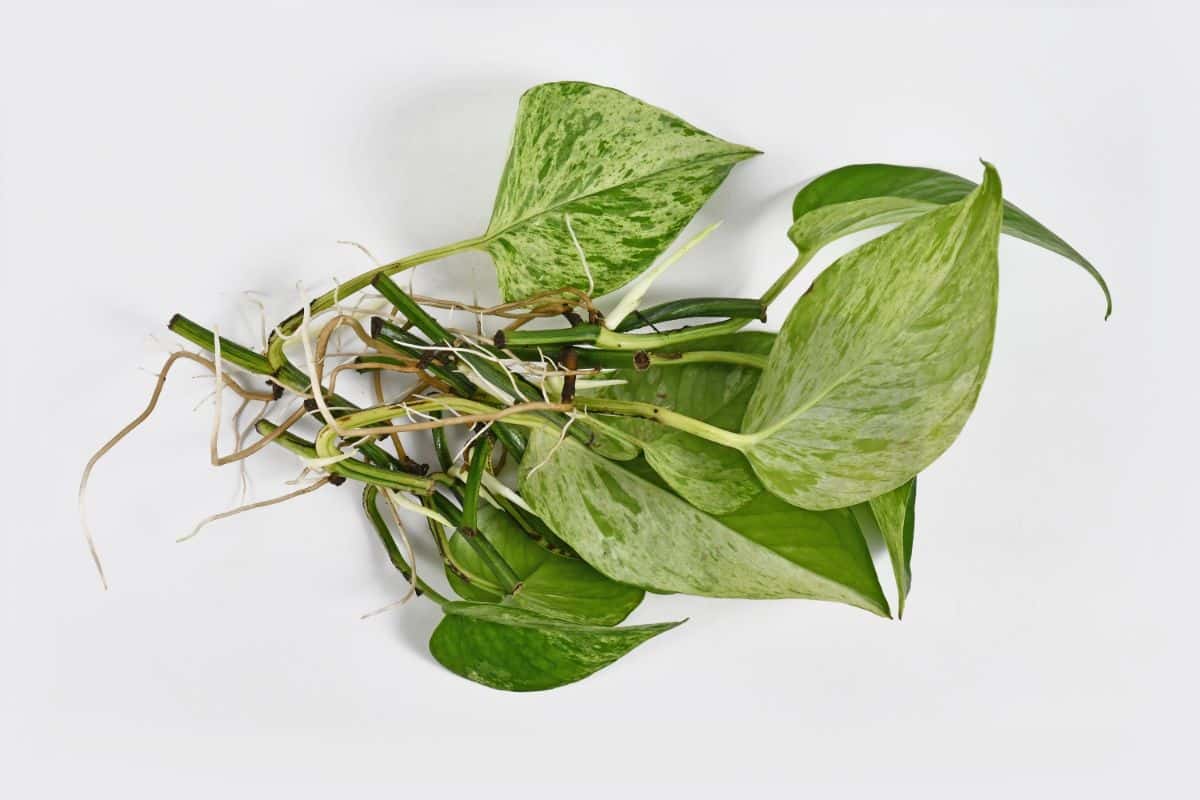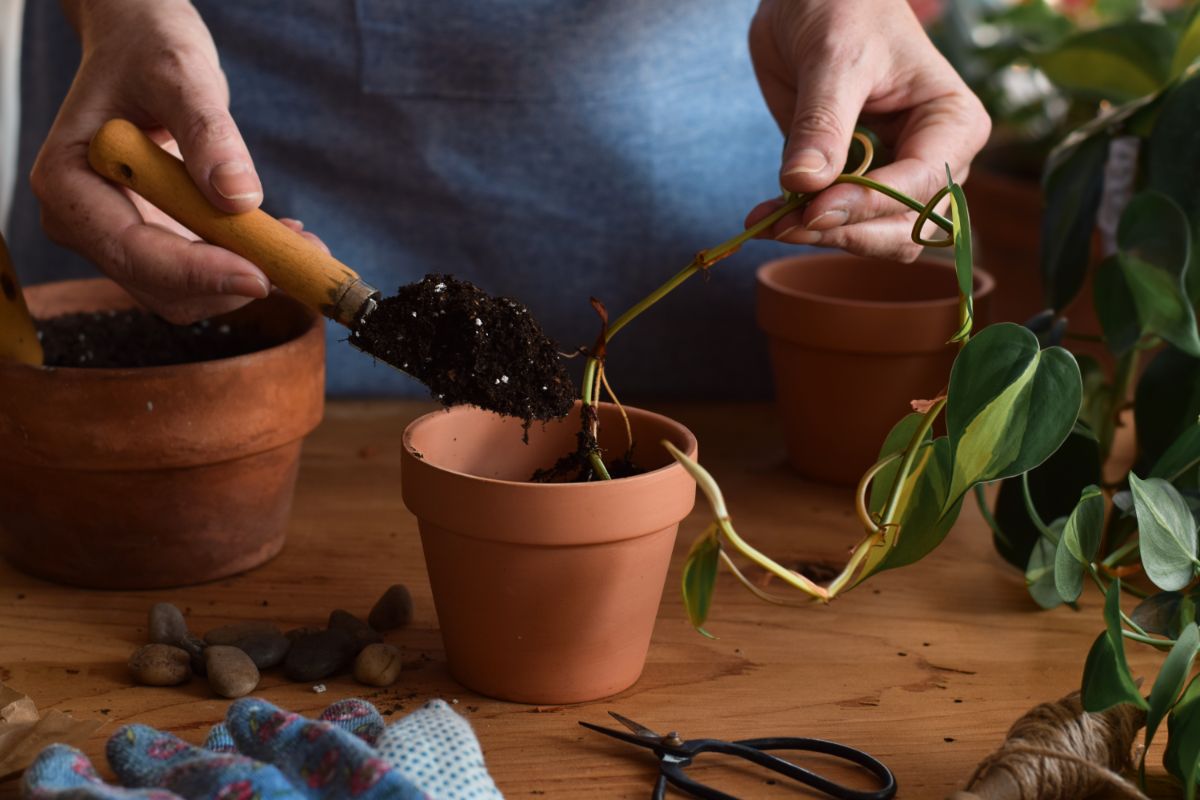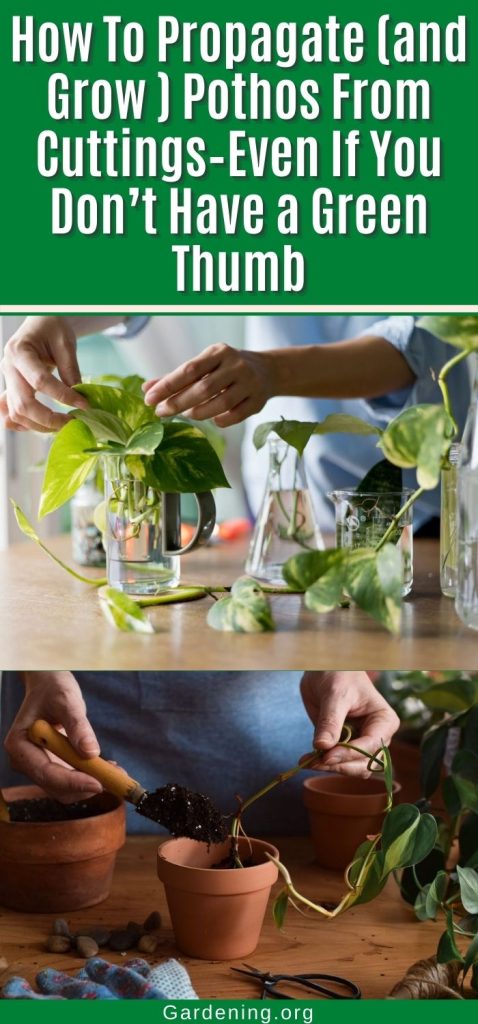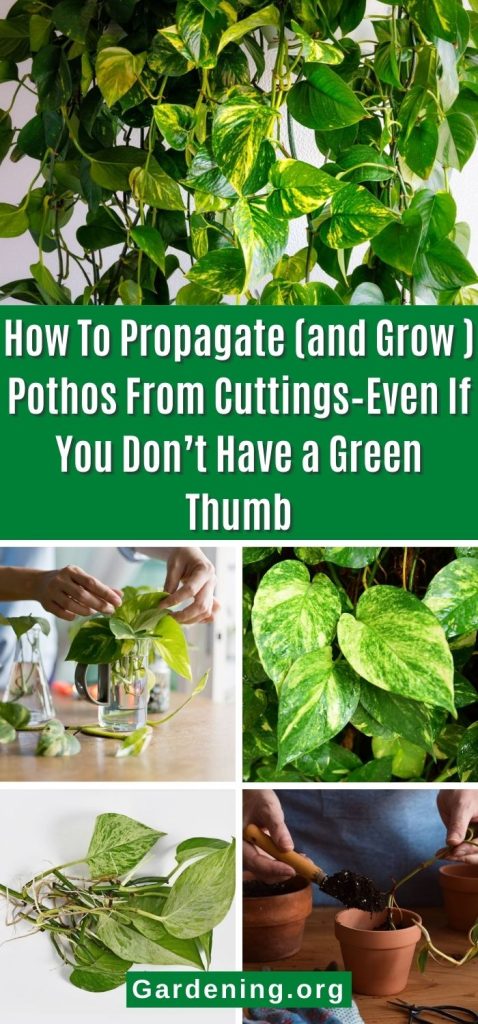Pothos has to be one of our favorite houseplants. They tolerate a wide variety of conditions, including neglect. Pothos are vining plants that will grow and grow even with less-than-perfect care.

I set one on top of my piano and forgot about it. I watered it once in a while when I remembered. The light is not great. I never dust the leaves. I forgot to fertilize it. A few months later, I noticed pothos vines had grown not only across the top of the piano but trailed down the side. They crept along the baseboard, scouting a way to cross the floor.
Native to the warm climates of the South Pacific and Southeast Asia, pothos has been given many names and classifications over the years. Their botanical name is Epipremnum aureum. A few other species are also sometimes lumped in as ‘pothos,’ so check the botanical name to be sure.
Jump to:
Varieties of Pothos to Try Propagating and Growing
- ‘Neon’ is as brightly colored as it sounds. Lime-green or chartreuse foliage contrasts nicely with other houseplants. Combine ‘Neon’ with ‘Jade’ to liven up a room.
- ‘Jade’ makes a simple and bold statement when covering your bookcase with vines. Its foliage is dark green and pure. No variegation or speckles. ‘Jade’ pothos just looks lush.
- ‘Golden’ has beautiful yellow-gold variegations. Some plants have more gold color than others, so pick the one that speaks to you.
- ‘Marble Queen’ displays white or cream-colored variegation. Some plants have so many patterns on the leaves that they resemble an expensive well-marbled steak. If your ‘Marble Queen’ variegations are turning yellow, take it out of the closet. It’s not getting enough light.
Ways To Propagate Pothos
Pothos is an excellent plant to propagate for beginners. If you think you can’t do this whole propagation thing, try it with a pothos. You’ll be hooked on propagation and get some success under your belt.
How To Grow Pothos From Cuttings

Pothos are commonly grown from cuttings; some people prefer to root them in water, some in soil. Both methods will work, with a few differences. To begin with, you’ll need to take some cuttings. Sanitize your snips or scissors to prevent spreading disease or fungi.
To take a Pothos cutting:
- Select a piece of stem with at least one node and a couple of leaves. Two or three nodes, air roots, and two or three leaves are okay. Choose a healthy, vibrant-looking piece of the vine. Vigorous plant tissue propagates much better than weakened material.
Pothos nodes look like little thickened spots with a leaf stalk protruding from the vine’s trunk. The node commonly has a brown aerial root growing near it and perhaps another leaf stalk. These aerial roots may be short, like little claws.
- Cut just below the node or air root with clean, sharp shears, ensuring the node is not damaged. Trim at a 45-degree angle. Root your cutting in soil or water following the directions below.
If rooting cuttings in water:
- Place the new cutting in a clear-walled container filled with water. Make sure the nodes are submerged. Trim off a leaf if needed. You don’t want any leaves submerged or touching the water.

- Ensure your water is clean and free from chlorine, fluoride, or other additives. If your tap water is treated, you may wish to buy a gallon of spring water from the store. You can also boil treated water for 15 minutes and let it cool. Or, leave a pitcher on the counter for a couple of days, allowing the chlorine and other contaminants to evaporate.
- Change the water every week to keep it fresh. Keep the jar in a brightly lit and warm spot out of direct sunlight.
- Watch for roots to grow. This is the fun part of propagating in water. They will first show as little white bumps. Once they grow a little longer, you can transplant your new pothos. Or, leave it in the water forever.
Transitioning from water to soil

Pothos propagated in water can be a touch tricky to transplant into a regular pot and potting soil. The roots that develop in water are not quite up to the task of gathering moisture from the soil until they adapt. Two ways of easing the transition for your water-rooted cuttings are:
- Transplant your water-rooted cutting into a pot filled with wet coco coir fibers. Begin by thoroughly wetting the coco fibers. Wrap a few around the roots of your new cutting, and tuck it into a container with more fibers. Keep the medium moist. After a few weeks, transplant to moist potting mix and grow like other houseplants.
- Begin adding a little soil to your water vessel every day. Eventually, the entire jar will be soil (potting mix), and your plant will have adapted.
If rooting cuttings in soil or another medium:
- Fill a container with a well-moistened potting mix or other rooting media such as rock wool or damp sand. Add some perlite if necessary to keep the mix light and fluffy.
- Stick your cutting in the pot, deep enough to cover the nodes. Be gentle.
- Firm the medium around the stem and place it in a bright location. A window that receives indirect sunlight or morning-only sunshine will work. Keep the medium damp.
- In a few weeks, you can check the progress of your new plants’ roots by gently giving the stem a little tug. If there is resistance, your pothos cutting has grown roots. New growth is also a good sign of root development.
Tips For Growing Pothos

- Pothos likes a container with good drainage. It does not mind drying out a bit more than most houseplants will tolerate but constant wet soil will cause root rot.
Use your finger to test the soil and water when the top two inches feel dry. Or, if you forget, give it a drink when the leaves barely start to wilt. One deep watering is better than many shallow ones.
- Give it some humidity. While pothos will grow with little attention, misting the plant to provide some humidity will make it happier.
- Let it climb or dangle. Pothos is a vine. In the wild, it dangles from trees until it finds something to climb and then does so. Display your beautiful pothos by setting it on a shelf, letting it trail over your dresser, or planting it in a hanging pot. They even like moss poles, although you may have to help it climb initially.
- While they don’t mind being a little pot-bound, eventually, your pothos will need a bigger container. Go up one size, i.e., from a four-inch pot to a six-inch pot. Provide fresh potting soil and make sure the new pot has adequate drainage.









Leave a Reply